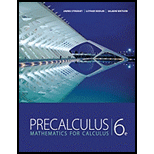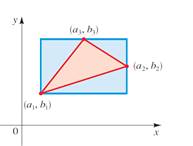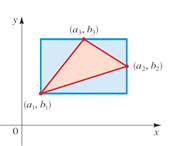
a.
The coordinates of the vertices of the surrounding rectangle and calculate the area.
a.
Answer to Problem 63E
The area of the rectangle is R=(a3−a1).(b2−b1)=a3b2+a1b1−a1b1−a3b2
Explanation of Solution
First finding the coordinates by seeing how the rectangle is formed by the lines x=a1,x=a3,y=b1,y=b2.
So, the line equation by noting he coordinates of the points on them. So, the four vertices of the rectangle are given by,
(a1,b1),(a1,b2),(a3,b1),(a3,b2)
The area of the rectangle id then simply,
R=(a3−a1).(b2−b1)=a3b2+a1b1−a1b1−a3b2
Conclusion:
Hence, the area of the rectangle is R=(a3−a1).(b2−b1)=a3b2+a1b1−a1b1−a3b2
b.
The area of the red tringle by subtracting the area of the three blue triangles from the area of the rectangle.
b.
Answer to Problem 63E
The area of the red tringle by subtracting the area of the three blue triangles from the area of the rectangle is 12(a1b3−a3b1−a2b3+a3b2+a1b2+a2b1)
Explanation of Solution
Calculation:
B=12(a3−a1|(b1−b3)+12(a2−a3)(b3−b2)+12(a2−a1)(b2−b1))B=12(a1b1+a3b3−a1b3−a3b1−a2b2−a3b3+a2b3+a3b2+a2b2+a1b1−a1b1−a2b1)B=12(−a1b3+b1a3+a2b3+a3b2−a1b2−a2b1)
So, the area A of the red triangle is then,
A=R−BA=12(a1b3−a3b1−a2b3+a3b2+a1b2+a2b1)
Conclusion:
Hence, the area is 12(a1b3−a3b1−a2b3+a3b2+a1b2+a2b1) .
c.
By using 12(a1b3−a3b1−a2b3+a3b2+a1b2+a2b1) show that the area of the red triangle is given by
area = ±12|a1b11a2b21a3b31|

c.
Answer to Problem 63E
Showed that the area of the rectangle is giving by the area = ±12|a1b11a2b21a3b31|
Explanation of Solution
Given:

area = ±12|a1b11a2b21a3b31|
Calculation:
First expand the determinant given the 3rd column,
|a1b11a2b21a3b31|=|a2b2a3b3|−|a1b1a3b3|+|a1b1a2b2|=(a2b3−b2a3)−(a1b3−b1a3)+(a1b2−b1a2)=−a1b3+a3b1+a2b3−a3b2+a1b2−a2b1
The sign of the difference arises from the loss of generality because the ordering picked for a1,a2,a3 and b1,b2,b3 is specific as given in the diagram in the book. So hence write the determinant in an absolute value to fix this and the final result is the proof as,
A=10abs(|a1b11a2b21a3b31|)
Conclusion:
Hence, area of the rectangle is giving by the area = ±12|a1b11a2b21a3b31| is proved.
Chapter 10 Solutions
Precalculus: Mathematics for Calculus - 6th Edition
- Math Test 3 3 x³+y³ = Ꭹ = 9 2 2 x²+y² = 5 x+y=?arrow_forwardFor each of the following series, determine whether the absolute convergence series test determines absolute convergence or fails. For the ¿th series, if the test is inconclusive then let Mi = 4, while if the test determines absolute convergence let Mi 1 : 2: ∞ Σ(−1)"+¹ sin(2n); n=1 Σ n=1 Σ ((−1)”. COS n² 3+2n4 3: (+ 4: 5 : n=1 ∞ n 2+5n3 ПП n² 2 5+2n3 пп n² Σ(+)+ n=1 ∞ n=1 COS 4 2 3+8n3 П ηπ n- (−1)+1 sin (+727) 5 + 2m³ 4 = 8. Then the value of cos(M₁) + cos(2M2) + cos(3M3) + sin(2M) + sin(M5) is -0.027 -0.621 -1.794 -1.132 -1.498 -4.355 -2.000 2.716arrow_forwardi need help with this question i tried by myself and so i am uploadding the question to be quided with step by step solution and please do not use chat gpt i am trying to learn thank you.arrow_forward
- i need help with this question i tried by myself and so i am uploadding the question to be quided with step by step solution and please do not use chat gpt i am trying to learn thank you.arrow_forward1. 3 2 fx=14x²-15x²-9x- 2arrow_forwardNo it is not a graded assignment, its a review question but i only have the final answer not the working or explanationarrow_forward
- Class, the class silues, and the class notes, whether the series does alternate and the absolute values of the terms decrease), and if the test does apply, determine whether the series converges or diverges. For the ith series, if the test does not apply the let Mi = 2, while if the test determines divergence then M¿ = 4, and if it determines convergence then M¿ = 8. 1: 2: 3 : 4: 5 : ∞ n=1 ∞ (−1)n+1. Σ(-1) +1 n=1 ∞ п 3m² +2 Σ(-1)+1 sin(2n). n=1 ∞ 2n² + 2n +3 4n2 +6 1 e-n + n² 3n23n+1 9n² +3 In(n + 1) 2n+1 Σ(-1) +1 n=1 ∞ Σ(-1)". n=1 Then the value of cos(M₁) + cos(2M2) + cos(3M3) + sin(2M4) + sin(M5) is 1.715 0.902 0.930 -1.647 -0.057 ● 2.013 1.141 4.274arrow_forward3. FCX14) = x²+3xx-y3 +.arrow_forwardA cylindrical chemical storage tank with a capacity of 950m3 is going to be constructed in a warehouse that is 11m by 14m with a height of 10m. The specifications call for the case to be made of sheet metal that costs $90/m2, the top to be made from sheet metal that costs $45/m2 and the wall to be made of sheet metal that costs $80/m2. If you want to minimize the cost to make the storage house, how much would you end up spending to build the tank?arrow_forward
- Calculate the max value of the directional derivatearrow_forwardCalculus III May I please have the example, definition semicolons, and all blanks completed and solved? Thank you so much,arrow_forwardA company estimates that the revenue (in dollars) from the sale of x doghouses is given by R(x) = 12,000 In (0.02x+1). Use the differential to approximate the change in revenue from the sale of one more doghouse if 80 doghouses have already been sold. The revenue will increase by $ if one more doghouse is made. (Round to the nearest cent as needed.)arrow_forward
 Calculus: Early TranscendentalsCalculusISBN:9781285741550Author:James StewartPublisher:Cengage Learning
Calculus: Early TranscendentalsCalculusISBN:9781285741550Author:James StewartPublisher:Cengage Learning Thomas' Calculus (14th Edition)CalculusISBN:9780134438986Author:Joel R. Hass, Christopher E. Heil, Maurice D. WeirPublisher:PEARSON
Thomas' Calculus (14th Edition)CalculusISBN:9780134438986Author:Joel R. Hass, Christopher E. Heil, Maurice D. WeirPublisher:PEARSON Calculus: Early Transcendentals (3rd Edition)CalculusISBN:9780134763644Author:William L. Briggs, Lyle Cochran, Bernard Gillett, Eric SchulzPublisher:PEARSON
Calculus: Early Transcendentals (3rd Edition)CalculusISBN:9780134763644Author:William L. Briggs, Lyle Cochran, Bernard Gillett, Eric SchulzPublisher:PEARSON Calculus: Early TranscendentalsCalculusISBN:9781319050740Author:Jon Rogawski, Colin Adams, Robert FranzosaPublisher:W. H. Freeman
Calculus: Early TranscendentalsCalculusISBN:9781319050740Author:Jon Rogawski, Colin Adams, Robert FranzosaPublisher:W. H. Freeman
 Calculus: Early Transcendental FunctionsCalculusISBN:9781337552516Author:Ron Larson, Bruce H. EdwardsPublisher:Cengage Learning
Calculus: Early Transcendental FunctionsCalculusISBN:9781337552516Author:Ron Larson, Bruce H. EdwardsPublisher:Cengage Learning





